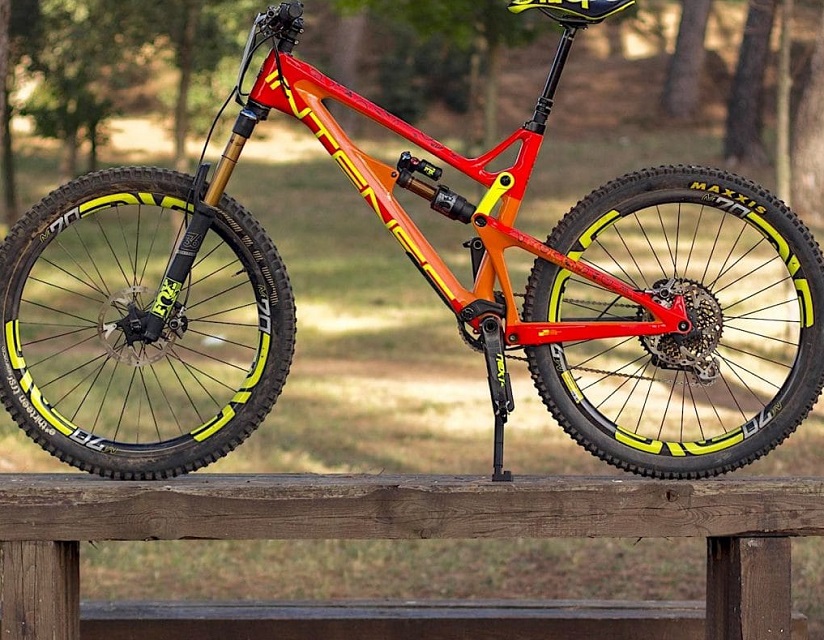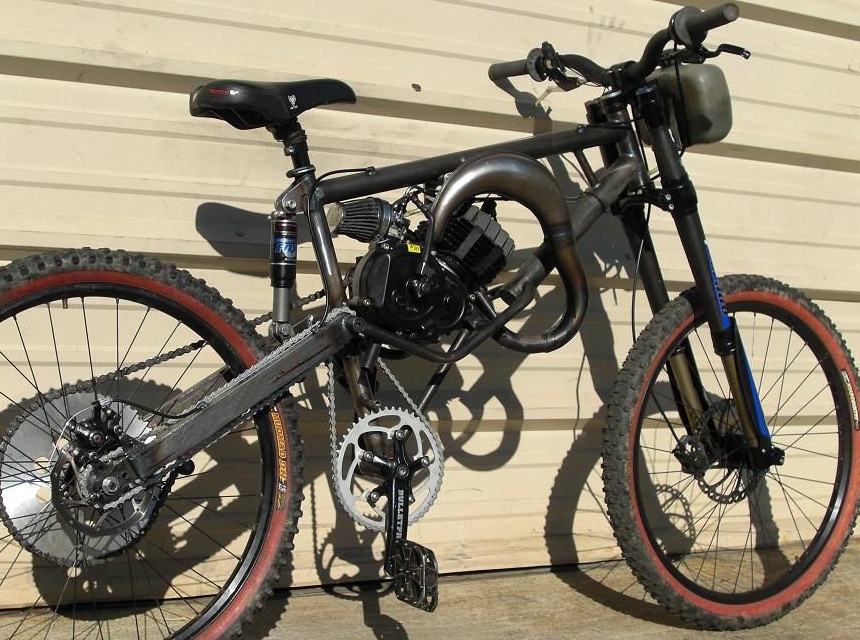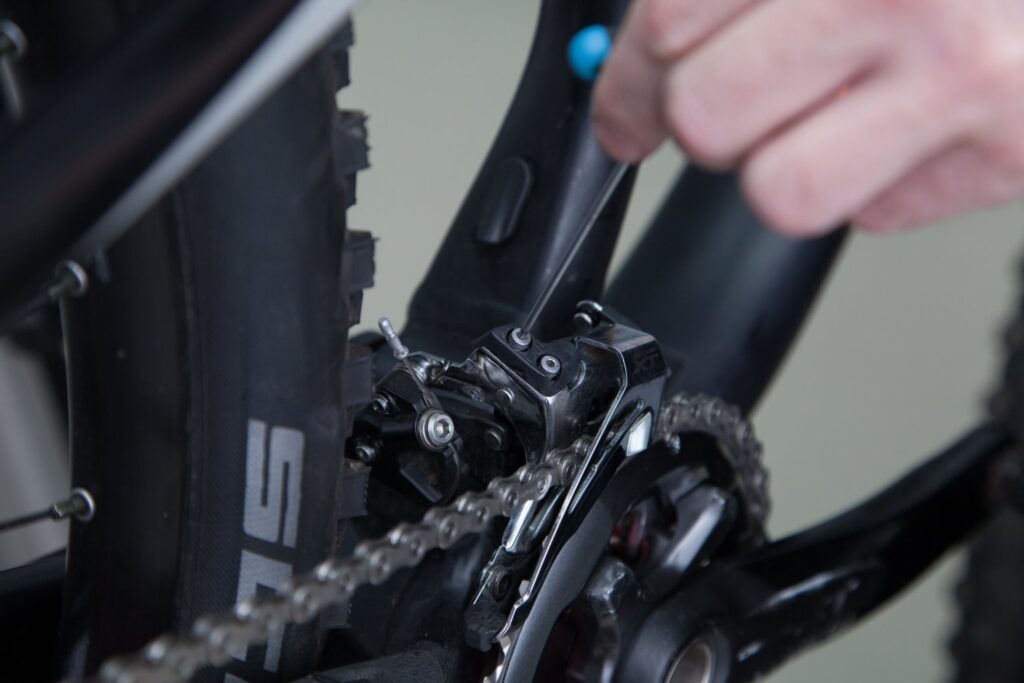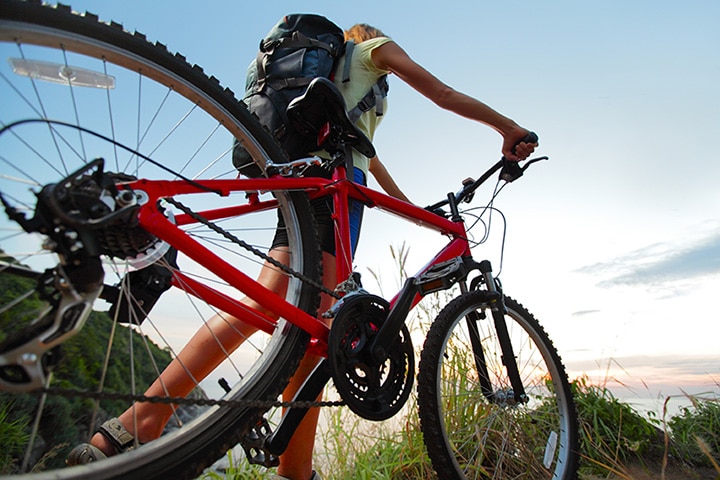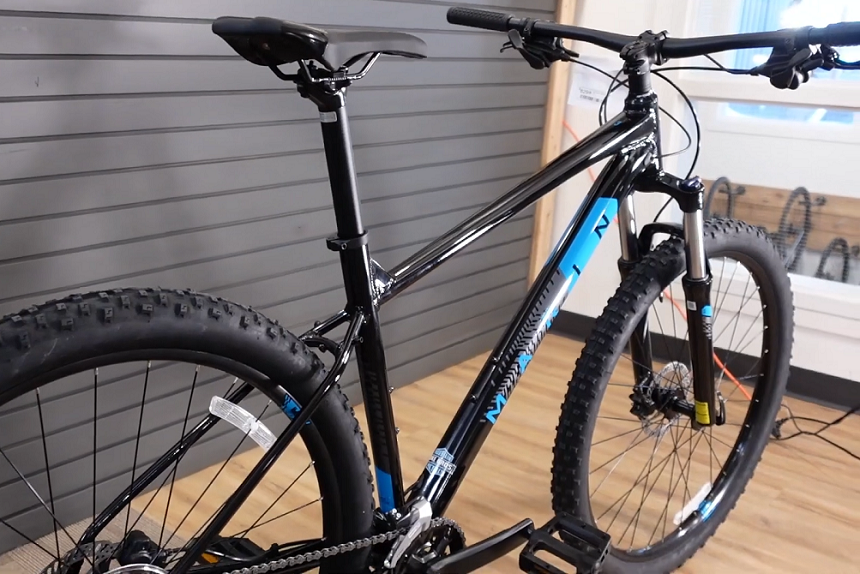- Trails
-
Bikes
-
Gear
-
Tips & Tricks
-
About us


So, you’ve recently discovered how interesting mountain biking can be from YouTube videos, social media, or your friends and are looking to give it a try. The problem is you don’t own a bike, and when you go online to order one, you see they come in different sizes. You could just wing it and pick the one that seems like it would fit you, but that’s a big risk considering they often cost upwards of several hundred dollars. So, what do you do? You consult a trusty mountain bike size chart. This helps you determine the right bike size for your height, leading to a better buying and mountain biking experience. We’ve got one of these size charts below and also explain other things you should consider.
If you’re a man, the mountain bike frame size chart below should work for you nine out of ten times. There may be some unique situations where your arm span is longer or shorter than your height, in which case, you need several other measurements apart from height.
However, if you’re like most other men whose arm span matches their height, a mountain bike size chart by height is often an accurate way to determine which bike size is the right fit, especially for first-timers.
| Rider Height (in) | Rider Height (cm) | Frame Size | Frame Size (in) | Frame Size (cm) |
| 4′ 10″ – 5′ 2″ | 148cm – 158cm | XS | 13″ – 14″ | 33cm – 37cm |
| 5′ 3″ – 5′ 6″ | 159cm – 168cm | S | 15″ – 16″ | 38cm – 42cm |
| 5′ 7″ – 5′ 10″ | 169cm – 178cm | M | 17″ – 18″ | 43cm – 47cm |
| 5′ 11″ – 6′ 1″ | 179cm – 185cm | L | 19″ – 20″ | 48cm – 52cm |
| 6′ 2″ – 6′ 4″ | 186cm – 193cm | XL | 21″ – 22″ | 53cm – 57cm |
| 6′ 4″ + | 194cm + | XXL | 23″ + | 58cm + |
Once you really get into mountain biking and every little thing affects your riding experience, you can go back to the drawing board and bring in other factors like reach, stack height, etc.
It’s worth noting that in the past, the most common sizing provided by manufacturers was the frame size in inches or centimeters. Typically the size given would refer to the length of the seat tube.
However, most modern mountain bikes are sized more or less like clothes, ranging from XS, S, M, L, XL, and XXL in the men’s mountain bike size chart. These are also the sizes you’ll see listed when you start shopping for your mountain bike.
Awareness of the inch and centimeter sizes can be helpful in case you come across an older-generation mountain bike on the market. Nevertheless, if you’re already looking at different mountain bike options, our list of the best mountain bikes and their pros and cons can help you make an informed purchase decision.
For riders who are 5’10”, reviewers seem to overwhelmingly recommend the Schwinn Traxion Mountain Bike, a full suspension bike with an 18-inch frame, 29-inch wheels, and mechanical brakes for optimal stopping power on your descents.
If you were to go into a bike shop, you’d also notice slight differences between the men’s and women’s mountain bikes. With women typically shorter than men Trusted Source Average Height for Women: America, World, Weight & More In the 1960s, the average American woman was around 5 feet 3 inches tall. How tall is she today? Discover the average height for women in the United States and other countries around the world. Also explore the relationship between height and weight, get tips if youre overweight for your frame, and more. www.healthline.com and also having wider pelvic areas Trusted Source A Wider Pelvis Does Not Increase Locomotor Cost in Humans, with Implications for the Evolution of Childbirth - PMC The shape of the human female pelvis is thought to reflect an evolutionary trade-off between two competing demands: a pelvis wide enough to permit the birth of large-brained infants, and narrow enough for efficient bipedal locomotion. www.ncbi.nlm.nih.gov , this is perfectly understandable. However, it necessitates having a separate women’s mountain bike size chart so you know exactly what size bike you should pick.
This is not to say that all men’s mountain bikes will be incompatible with women and vice versa. You can still get lucky and get a man’s mountain bike that fits you like a glove. However, if you’re uncomfortable leaving that up to chance, using the MTB size chart below should help ensure you’re satisfied with your first mountain bike purchase.
Notably, if you’re looking for a decent woman’s MTB for cheap, our list of the best women’s mountain bikes under $500 is a great free resource you can use. Also, according to previous buyers, the Mongoose Status Mountain Bike is one of those women’s bikes in this price range that’s likely to give you a good experience. It’s a 21-speed bike with 26-inch wheels, dual suspension, and an aluminum frame.
| Rider Height (in) | Rider Height (cm) | Frame Size | Frame Size (inches) | Frame Size (cm) |
| 4’10” – 5’2″ | 148cm – 158cm | XS | 13″ – 14″ | 33 – 37 |
| 5’2″ – 5’6″ | 158cm – 168cm | S | 15″ – 16″ | 38 – 42 |
| 5’7″ – 5’9″ | 168cm – 178cm | M | 17″ – 18″ | 43 – 47 |
| 5’10” – 6’1″ | 178cm – 185cm | L | 19″+ | 48 + |
Mountain bikes are sized according to the size of the frame. Often you’ll notice that apart from kids’ bikes which have 24” wheels and smaller, most adult bikes have similar wheel sizes and suspensions, so the only difference is typically the frame size. That said, if you’re also looking for a decent small mountain bike for your loved ones, we’ve listed some of the best 24-inch mountain bikes backed by comprehensive research and user reviews.
Mountain bikes were traditionally sized according to seat tube length. However, due to the evolution of mountain bike designs, most manufacturers now categorize their bikes as medium, large, extra large, etc.
This is because the seat tube length has become less relevant to the user than measurements like reach and stack height.
The stand-over height also used to be a pretty good measure of whether a bike was the right fit for you or not. While it may still be relevant to road bike users, mountain bike designers have dropped the top tube lower and lower for new bike models. As such, it can no longer be used as an objective measure of whether a bike fits you.
Mountain bike geometry measurements tell you the exact shape and size of the bike. Some consider these geometry measurements even more accurate than a specialized mountain bike size chart in determining the bike size you should go for.
Overall, the bike geometry measurements determine the feel, fit, and even style of the mountain bike, all of which are influential in your ride experience. They are also used in official games like triathlons, time trials, etc., and include measurements like chain stay length, bottom bracket height, reach, head tube angle, stack height, etc., discussed below.
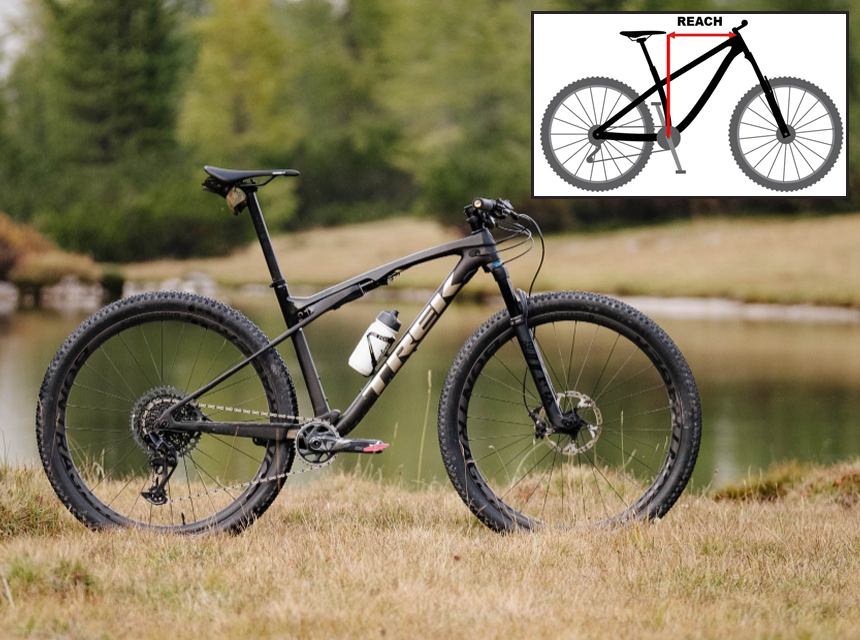
Reach is considered one of the most important mountain bike geometry measurements alongside stack height and typically refers to the horizontal distance between the center of the head tube and your bottom bracket.
If your bike’s reach is too small, the bike may be trickier to control, especially at high speeds. Naturally, this makes it less safe than an appropriately sized bike. You’ll also likely be in a cramped riding position which can lead to injury in addition to being fairly uncomfortable.
Similarly, bikes with a reach that’s too big are uncomfortable to ride and difficult to control. Also, even if you avoid getting into accidents, they can still cause injury due to the awkward riding position.
Stack height, on the other hand, refers to the vertical distance between the middle of the head tube and the bottom bracket. This will typically determine how comfortable you’ll be with seated cycling.
Unlike reach, which can barely be adjusted, there are ways to adjust the stack height, such as adding headset spacers and raising or lowering the handlebar. That said, stack height isn’t nearly as important as reach where mountain bikes are concerned though the situation may be different for road bikes.
Another geometry measurement that greatly influences your mountain biking experience is the head tube length and angle. The angle is particularly important since it determines how your bike handles in specific scenarios assuming you have optimal reach.
It measures the angle between the front fork and the ground. Your mountain bike is described as having a “slack” head angle if you get a lower angle. Conversely, those with a higher angle are described as having a “steep” head tube angle.
So, what are the implications of both steep and slack head tube angles?
With a slack head tube angle, handling is a bit more difficult on an incline or uphill terrain. Often you need to put your weight on the front wheel to maintain balance and keep your bike from doing wheelies.
While this is a chore, the sacrifice is worth it for the added control you get at high speeds, such as when you go downhill. Most mountain bikers have the most fun going downhill, and MTBs with slack head tubes are best suited for these scenarios.
Naturally, bikes with steep head tube angles are the exact opposite. They’re much easier to climb with, but they can be unstable when going downhill. More experienced riders can offset this by putting most of their weight on the back wheel, but it’s no easy feat at high speeds.
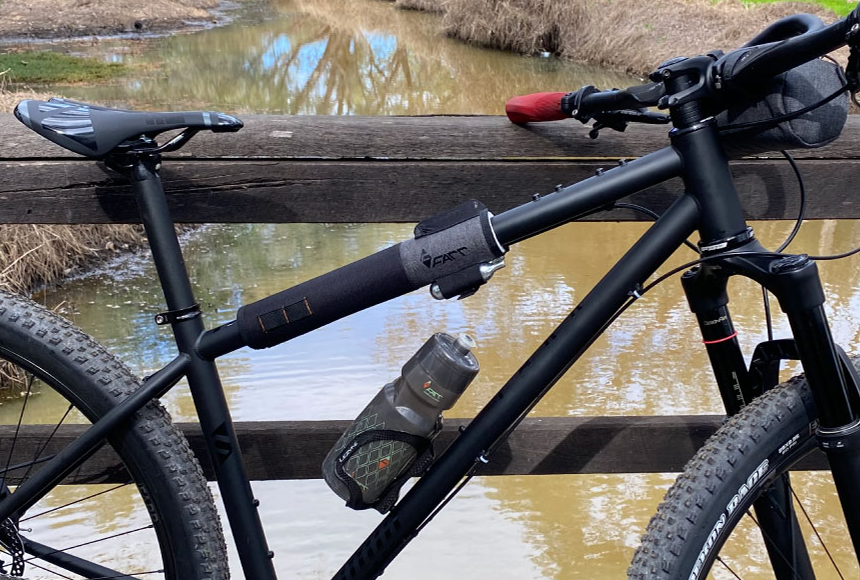
The basic top tube length and effective top tube length. The basic length is the distance between the tops of the head tube and the seat tube. However, this has proven not to be a good measure of how roomy a bike is.
On the other hand, the effective top tube length is a virtual horizontal measurement of the distance between the middle of the seat post and the top of the head tube. Unfortunately, this is not a measurement you’re likely to find on a bike vendor’s website when shopping for your next ride.
The seat tube length is measured from the middle of the bottom bracket to the top of the seat tube. In the past, when a mountain bike seat tube was 16”, the bike had a 16” frame, which would dictate the height of riders it was compatible with.
Now, this has changed, with seat tube length being significantly less important.
It might still be a good idea to know your bike’s seat tube length, so you compare it with your next purchase.
As for the seat tube angle, it typically ranges from 71-74 degrees and barely affects the rider’s experience.
As for the effective seat tube angle, it’s the angle of the line connecting the MTB’s bottom bracket to the top of the seat post. It’s a more accurate measurement of the rider’s hip placement relative to the position of the pedals. As such, it’s also a great indicator of bike fit and handling once you’re used to mountain bikes.
Once you find a bike that’s the right fit for you, you can measure the effective seat tube angle and then check for something similar in subsequent purchases. However, for most newbies, it might not matter as much as measurements like stack height and reach.
The chainstay length refers to the distance between the rear axle and the bottom bracket. The ideal chainstay length is different for every rider and typically depends on the riding dynamics they want.
For instance, riders can be more dynamic with how they move their weight while riding with a shorter chainstay length. After all, the rear wheel is basically underneath them. This also allows them to do wheelies and lift the front wheel while they cycle.
With a longer chainstay length, you get more stability from your bike, allowing easier handling at top speeds.
The bottom bracket height, or the bottom bracket drop, as it’s called in some circles, is the distance from the ground to the middle of your mountain bike’s bottom bracket with the suspension fully extended.
Interestingly, bikes with a smaller bottom bracket drop easily transition from corner to corner. As such, it should be an asset if you’re going down an MTB trail with many corners.
However, it can also be a liability, especially on technical trails where there are lots of bumps since your bike may not be able to clear them. Skilled riders have the technique to make sure this is not a problem. However, if you’re new to mountain biking, it might be better to go for something with a larger bottom bracket height and limit your speeds when going downhill for effective cornering.
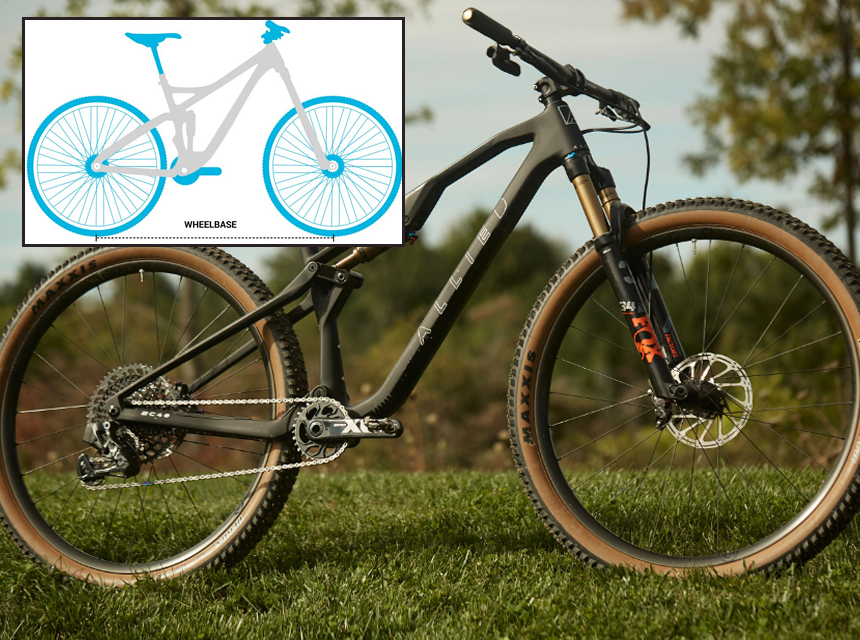
Lastly, the wheelbase is the distance between the front and rear wheel axles.
Bikes with short wheelbases are more maneuverable at lower speeds, but you sacrifice stability. Similarly, one with a longer wheelbase offers great stability, especially at high speeds. However, turning and handling may be a problem at lower speeds.
You start by placing the bike diagonally across a room corner. The rear tire should touch one wall while the handlebar touches the other. You then measure the distance between the back wall and the middle of the bottom bracket.
You follow up by measuring the vertical distance between the floor and the middle of the bottom bracket. This is your bottom bracket height.
After that, you measure the horizontal distance between the back wall and the middle of the handlebar. From this reading, subtract the figure you got from measuring between the wall and bottom bracket to get the reach.
Also, measure the vertical distance between the floor and the middle of the handlebar. Once you subtract the bottom bracket height you got earlier to get the stack height.
Mountain bike sizing is slightly different from gravel bike sizing, so you may need a different sizing chart to determine which gravel bike frame size is right for you. There are some similarities. For instance, men who are 4’ 10” to 5’ 2” tall should go for XS sizes on gravel and mountain bikes.
Some differences are evident on the other end of the size spectrum. A 6’4” man would need an XL gravel bike but an XXL mountain bike. We’ve prepared a gravel bike size chart, so you could easily choose the perfect bike of any type.
In addition to problems with handling and stability, several other issues come from picking the wrong-size mountain bike. Back pain Trusted Source Bicycling and Back Pain | Spine-health Information on how biking or bicycling sports injuries cause back pain, how to prevent low back pain when bicycling. www.spine-health.com , for instance, is one major issue. If you try different sizes and still end up with back pain, it may be an issue with your core strength rather than your bike size. However, you can only confirm this with your doctor.
Shoulder, arm, and neck pain neck pain Trusted Source PREVENTING NECK AND BACK PAIN IN CYCLISTS The positions that cyclists get into both on the mountain and road bikes can put a lot of strain on the neck and back. Dr. Tom Miller talks to osteopath Dr. Rich Kendall, chair of the Department of Rehabilitative Medicine at the University of Utah, on the best way to keep the neck and back healthy when on the bike for long periods. They also discuss how to treat the pain if it’s already begun. healthcare.utah.edu can also indicate problems with reach and stack height. Lastly, if your bike seat is too high or too low, you will likely encounter hip problems.
Easy access to a mountain bike size chart can likely save you the trouble of traveling to bike shops, which are increasingly rare and testing out several bikes for the right fit. Instead, you can order one from the comfort of your home without having to worry about whether you’ll get the size wrong. This is especially useful for beginner cyclists who aren’t as educated on mountain bike sizes as regular cyclists.
